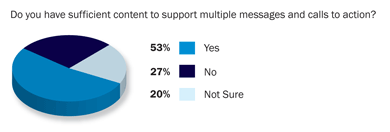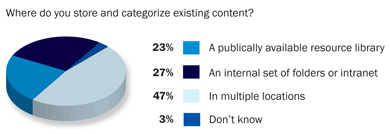Even High-Performing Marketers Struggle with Content, Alignment
- Published in Feature Articles
By Amy Bills, Director of Field Marketing, Bulldog Solutions
Continued struggles in sales and marketing alignment, challenges with marketing automation implementation and the ongoing need for compelling content plague even high-performing marketers, who find they have significant steps to take to shore up the foundations of their demand-generation programs.
These are the key findings from the Executive Benchmark Assessment (EBA), a survey created by Frost & Sullivan, the Growth Partnership Company, and demand generation agency Bulldog Solutions to measure the efficacy of BtoB marketers and provide benchmark data.

The EBA surveyed 250 BtoB marketers between June 2009 and January 2010, asking them to provide information in four key areas considered critical to sustainable, repeatable demand generation: Strategy, Technology, Content and Data. Participants received a custom report showing how they compare to industry recommendations and highlighting areas for improvement.
The results of the EBA show even high-performing marketers struggle.
“Demand generation is such a complex process,” said Rob Solomon, CEO and founder of Bulldog Solutions. “To really understand it, you have to recognize that there are lots of moving parts. And if you don’t have these core elements right, anything else you do is really just academic, because you won’t be able to repeat or measure it.”
Among the findings:
Strategy and alignment is about creating a clear, common set of objectives. Many organizations have heard the call and attempted to move toward better communication, including and SLAs between sales and marketing that spell out key agreements such as how a high-quality lead is defined. Nonetheless:
- Less than one-quarter of BtoB marketers say they’re generating enough demand to satisfy their sales teams.
- Less than half (46%) have developed buyer personas to guide communications and sales readiness for their prospects.
- Slightly below two-thirds, 64%, have defined the stages of the pipeline in order to ensure marketing and sales agree on common definitions.
Technology is the engine that enables best practices demand-generation tactics such as lead nurturing and lead scoring as well as the integration of multiple programs. The survey found more than half (52%) of marketers use some sort of marketing automation platform. This is a higher rate of adoption than found in other research, accounting for the relative sophistication of the survey group. However, although lead nurturing and message testing are both proven to increase efficacy of online marketing programs:
- Only 33% have an effective lead nurturing process.
- Only 36% leverage marketing automation or manual processes for message testing.
The custom communications enabled by marketing automation have put significant requirements on organizations to create compelling content. If technology is the engine, content is the fuel. Indeed, the pressing need for content across a range of buying stages and personas was the third greatest challenge identified by the survey group to leveraging marketing automation, behind only people/skillsets and appropriate process. Other findings:

- Slightly more than half, 53%, of marketers said they have sufficient content to support multiple messages.
- Only 23% store public-facing content in a publically available library or content center. For the rest, content is in multiple locations or an internal set of folders.
At the core of successful demand generation is data. Reliable, clean data is critical not only to effective communications based on profile and behavioral information, but also to accurate reporting to validate and improve. While the complexities of maintaining data continue to plague marketers, the findings show progress in key areas such as ability to segment (32% are able to segment on multiple data points; 43% can do basic segmentation).
Amy Bills is director of field marketing for Bulldog Solutions. Receive a custom report showing how you measure up to recommended best practices by participating in the Executive Benchmark Assessment.

